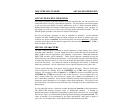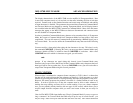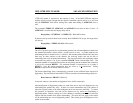
MFJ-1278B MULTI-MODE ADVANCED OPERATION
Hardware Flow Control
Hardware flow control is less likely to depend on the programming of a particular
communications program. DTR and CTS are normally used for flow control signals in
Transparent Mode. The command XFLOW OFF enables hardware flow control in
Converse Mode and Command Mode. Your computer may receive as many as 2 characters
after it signals the MFJ-1278B to stop sending, since some characters may already be "in
route" through serial I/O chips. Refer to Chapter 7, Hardware for details on the interface
required for hardware flow control.
Type-in Flow Control
Type-in flow control, enabled with the command FLOW, is really a display feature. It can
keep the MFJ-1278B from interrupting you with incoming packets when you are in the
middle of typing a command line or an outgoing packet. As soon as you type the first
character of a line, the MFJ-1278B will put a "hold" on all output (except for echoing your
input). The "hold" remains in effect until you type a <CR> to end the command line, or a
send-packet character to mark the end of a packet, or until you erase or re-display the line
you have started.
Some computers have difficulty simultaneously sending and receiving characters over the
serial port. This is most commonly the case for computers with "software UARTs." Type-
in flow control will improve the operation of such computers with the MFJ-1278B.
DETAILED VHF PACKET OPERATION
The previous chapter's discussion of "Basic Operation" contains enough information for most
packet operation. This section describes a few other aspects of packet operation.
Station Identification
Your station identification (call sign) is set with the command MYCALL, as described in the
previous chapter. If you will have more than one station on the air operating with the same
call sign, they must be distinguished, no two stations can have identical station
identifications, or the packet protocol will fail. You can distinguish additional stations by
setting the "secondary station ID", or SSID. This is a number from 0 to 15, appended to the
call sign with a dash:
cmd: MYCALL W3IWI-3
If you do not specify the SSID extension, it will be 0, and the MFJ-1278B will not explicitly
show SSIDs that are 0. If you want to connect to a station with a SSID other than 0, or use
such a station as a digipeater, you must specify the SSID:


















